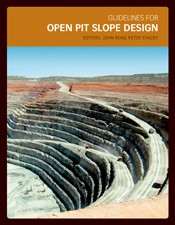This book is a comprehensive account of the open pit slope design process, and provides an up-to-date compendium of knowledge of the slope design processes that should be followed and the tools that are available to aid slope design practitioners. This book links innovative mining geomechanics research into the strength of closely jointed rock masses with the most recent advances in numerical modelling, creating more effective ways for predicting rock slope stability and reliability in open pit mines. It sets out the key elements of slope design, the required levels of effort and the acceptance criteria that are needed to satisfy best practice with respect to pit slope investigation, design, implementation and performance monitoring.
Information on gathering all of the field data that is required to create a 3D model of the geotechnical conditions at a mine site; how data is collated and used to design the walls of the open pit; how the design is implemented; up-to-date procedures for wall control and performance assessment, including limits blasting, scaling, slope support and slope monitoring; and how formal risk management procedures can be applied to each stage of the process. This book will assist in meeting stakeholder requirements for pit slopes that are stable, in regards to safety, ore recovery and financial return, for the required life of the mine.

John Read
Peter Stacey
Chapter Outlines
A Guidelines for Open Pit Slope Design book contains 14 chapters that follow the life of mine sequence from concept through to closure.In order to help the practitioner deal with short comings in the investigation and design process, each chapter deliberately focuses on leading issues such as what data is required, how it should be processed and which analysis should be used. The chapter contents are as follows:
Outlining the fundamentals associated with achieving a balanced design in terms of the expectations of the various stakeholders in the mining operation (owners, management, workforce and regulators), including:
- the aims of pit slope design;
- the framework, both corporate and regulatory, that control slope designs; and
- the geotechnical requirements at each stage of project development, from the initial conceptual study through pre feasibility and feasibility to detailed design, operation, and mine closure.
Outlining the availability and application of the mainstream technologies that are used to provide a functional engineering classification of the rock mass for slope design purposes.
Linking the regional geology and the events that lead to the formation of the orebody to a mine-scale description of the nature (rock type, degree of weathering and alteration) and distribution of each geological unit on site.
Describing the orientation, distribution and nature of; through-going faults at the regional, overall pit slope and inter-ramp scales, and lesser faults and joints (fabric) at the inter-ramp and bench scale
Describing the engineering properties of the rock mass and its constituents, including:
- the nature of the standard index and mechanical property tests that are used in rock slope engineering;
- the properties of the mechanical defects in the rock mass, especially shear strength and the effect of surface roughness;
- rock mass classification systems; and
- current and newly developed means of assessing the strength of the rock mass.
Describing how the presence of groundwater and the resulting pore water pressure may affect open pit design and performance, including:
- discussion of groundwater hydrogeology and its implications for rock slope engineering in the mining industry;
- a practical explanation of hydrogeology, including the concepts of fracture groundwater flow, how groundwater relates to pore pressures, and the relationship between total and effective stress;
- a distinction between general mine dewatering and slope depressurisation; and
- how a conceptual hydrogeological model is developed, including recharge to fractures, phreatic and piezometric surfaces, vertical and horizontal hydraulic gradients, discharge of water to the slope, the resulting pore pressure distribution in fractured rock.
Data compilation and assessment, focussing on how the data presented in Chapters 3, 4, 5 and 6 is processed and made ready for use in the design analyses. The aim of the chapter is to both highlight and provide guidance on those slope design issues for which clarification is frequently being sought.
Addressing the question of how to assess the reliability of information derived from data that represents only a small portion of a large parent group, and establishing a geotechnical reporting system that reports the uncertainties that are present in the geotechnical data to mine operators, corporate mine management, and the investment community.
Outlining the current deterministic and probabilistic acceptance criteria used by management and the potential application of newly developed risk and consequence approaches to supplement the methods now being used.
Highlighting current and newly developed methods that may be used to predict, back-analyse, and formalise the slope design, optimise the bench, inter-ramp and overall slopes, and estimate the reliability of the final pit walls.
Focussing on the operational requirements of mine planning, controlled blasting, slope protection measures, and artificial support.
Outlining measures to be adopted for evaluating the performance of the as constructed walls of the pit, slope monitoring and a ground management plan.
Outlining how general risk management concepts and processes can be applied to the geotechnical risks associated with each stage of the open pit slope design process.
Covering the processes and issues to be addressed, statutory requirements, and NGO pitfalls in the mine closure process.


